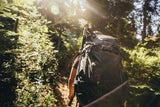The Camping Gear that Should be in Every Home Survival Kit

Outdoors people who know what camping gear to use in their home’s emergency survival kit can rest easy knowing that should a disaster hit, they’re sitting (relatively) pretty. For campers and hikers the importance of preparation hardly needs re-stating. The organized among us already keep our camping gear ready, grab bag-style, so we can hit the road the moment wanderlust strikes. Applying the same preparedness to our home emergency kit is the best way to cover our bases should things go sideways, a-la COVID-19, or worse. Here are 5 pieces of camping gear that everyone should have in their home emergency kit.
Matches & Lighters
It's one of the ten essentials (for the full list of wilderness essentials click here) and it's a no-brainer to add to a home emergency kit as well. Whether it's to light a camp stove, a candle or to start a fire when the heat's out, you'll want a way to make fire. Next time you're at the gas station or browsing Amazon, add some matches and lighters to your cart.
Portable Lighting
Anyone who’s gone camping knows how indispensable lanterns, flashlights and headlamps become once the sun goes down. While one could argue that light isn’t a basic need such as food, water or shelter; good luck doing anything in a pitch black room should the electrical grid go out. Luckily, human civilization has mastered quite a few alternative light sources by now, leaving you with a galore of options to include in your emergency kit. Among those options are candles, solar lights, crank-powered lights and battery powered lights. If you already have trusty (preferably portable) lights in your camping kit - perfect! Make sure to stash them somewhere accessible, fully charged with replacement batteries nearby. As previously mentioned, a portable light source is preferred in any kind of outdoor or emergency situation, due to its flexibility and independence from an electrical grid. If your light requires a battery – an LED light for example – battery length is important as there’s no knowing how long you’ll be needing said light source.

Camp Food
Dehydrated and freeze dried meals don't just make convenient food for overnight backpacking trips, they're also ideal additions to a home emergency kit. They take up minimal space in your kit, they'll last forever (or just about), and they're easy to prepare. Some favorite brands among backpackers include Mountain House, Backpacker's Pantry and Alpine Aire. If you're looking to stock up, we recommend getting the Mountain House bulk pack from Costco.
Cooler
If a power outage strikes, your lights aren’t the only thing that will go out, your appliances will too. With your fridge and freezer out of the picture, you’ll need a cooler in order to save your perishables for as long as possible. Not only will it save your food for a while, but the ice in it can also be used for cold compression for potential injuries. Keep a cooler stored near your at-home survival kit and make sure to have 3-5 ice packs in the freezer at all times. The same cooler you use on road trips, camping trips and fishing trips will work just fine. You shouldn’t solely rely on a cooler as your emergency food cabinet. Always make sure to stock up on non-perishable foods. If you’re unsure how best to pack your cooler or are in search of a new one, we recommend reading our guides on how to pack a cooler and what to know when buying one.
Camp Stove & Fuel
Simple canister stoves for camping start at around $50 dollars and can pack down to the size of a Pez dispenser. Adding one to your home's disaster prep kit along with a few canisters of fuel is relatively low cost and provides a backup plan for boiling water and preparing meals. There are a few reputable brands making camp stoves. If you have a favorite camp stove that you think doubles as a good backup emergency stove, leave us a note in the comments.
First-Aid
Ice won’t alleviate all pains and neither will Band-Aids heal all wounds, but the latter is still an essential part in a proper first aid kit, which in itself is a crucial part of any emergency kit. You take a first-aid kit every time you go hiking or backpacking. Make sure your at-home emergency kit has one, too. When getting a first aid kit you have the option of either making your own or buying an already existing one. Both are good options, but it’s important to keep in mind that it should be tailored to you and your family’s needs (this is where your at-home kit might differ from your camping first-aid kit). Make sure it has any required medication specific to you as well as things such as bandages, Band-Aids, cleansing wipes, safety pins, tweezers, and scissors, to name a few. There are of course several more things you can have in your first aid kit and we encourage you to educate yourself further on the matter so that you can make a kit that best suits you. This webpage from the American Red Cross is a good starting point if you want to make your own first aid kit.
Sleeping Bag
Without electricity and heat, keeping warm becomes a matter of insulation. If you’ve spent nights in the backcountry you know the satisfying feeling of tucking into a well-insulated sleeping bag. Sleeping bags are a standard piece of camping gear, and even the occasional camper should have one on hand. Simply storing your sleeping bag (and pad) near your at home emergency kit will give you insurance against the cold. It’s also important to make sure your sleeping bag has been maintained properly and still has working insulation. Insulation in sleeping bags has a lifespan and if they’re packed improperly, that lifespan becomes a lot shorter. If you’re uncertain if your sleeping bag is cut out for a survival scenario, we have a guide on what to know when buying a sleeping bag that covers the basics: different types of insulation, different shapes and sizes, and other important features.

Water Treatment
Water is, quite literally, life. It’s essential in day to day life and emergencies alike. Should you suspect that you might end up in a situation where the tap water is compromised, it’s recommended to have enough water to last each person in your home for three days (roughly 1 gallon per day per person) and have some sort of water purifier at hand, in case the water gets contaminated in any way. For the backpackers and off-grid campers among us, a simple solution is to store your camping water treatment device (filter or purifier) in your at-home emergency kit when you’re not using it.
The beauty of camping gear is that it’s built for rugged conditions, dynamic weather and the unpredictability of nature, which makes it perfect for emergency situations at home, too. Use the gear mentioned above to start your own home survival kit or to update the one you already have. Our goal here is not to sound alarmist, but to emphasize the importance of staying calm, educated and prepared. Stay safe and healthy!
-
Shop the gear from this post:







